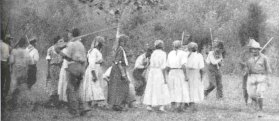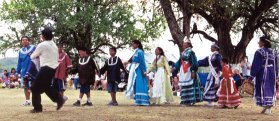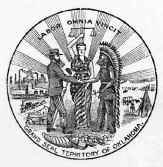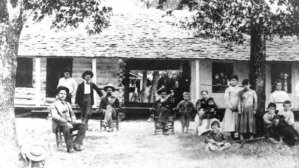 |
| NHC Home |
|
The Effects of Removal on American Indian Tribes Clara Sue Kidwell, University of North Carolina at Chapel Hill ©National Humanities Center |
|
(part 7 of 7)
GUIDING STUDENT DISCUSSION
"This part of the red race have suffered most from the whites; their comfortable eastern homes have been broken up, their thrifty farms and fruitful orchards abandoned for a western wilderness where thousands have died of exposure."
Gen. S. C. Armstrong, "The Indians," The American Missionary, January 1883, on the Indians forcibly moved to the Indian Territory full text
Students should consider the factors that motivated the United States government to attempt to dispossess whole groups of peoples of their lands. In a comparative sense, the Holocaust in Europe, the internment of Japanese during World War II, and, today, ethnic violence in Bosnia, Africa, and Chiapas, Mexico, can show that the motives of nationalism and "ethnic cleansing" still go on in the modern world.
recreating the world"European colonialism brought people to the new world to exploit its natural resources. Native people lived in an environment which they considered as their sources of power. Ceremonies such as the Green Corn Dance were part of the process by which they interacted with the environment, and they believed that they played a causal role in the processes of the environment. (Christian churches had replaced traditional ceremonialism for many tribal members, but ceremonies such as the Green Corn dance persisted.) An origin story from a local tribe, and a description of a ceremony, can show how Indian people explained the form of their environment, the spiritual beings who were involved in its creation, and the way in which ceremonies play a role in recreating the world (see online resources). Students should think about Christian attitudes toward nature—are humans indeed stewards of the land? Should they feel a responsibility to the land? How do they explain their own environments in a scientific sense, but also, what are their particular memories of significant places in their own lives? What does the notion of place convey to them?
Grand Seal, Territory of Oklahoma, c. 1900
Motto: "Work Conquers All"From the Native perspective, the choice can be presented simply as that between remaining a self-governing people with their own laws in a new land, or remaining in their homes as subjects of a foreign government. This simple dichotomy does not mean that Native communities were unified in making one choice or the other. What choices would students make in those circumstances, and why? Many Native leaders were confronted with the necessity of resisting pressures for removal when they personally favored the move to protect tribal sovereignty.
Students should think about the choices that Europeans made to seek religious freedom in new lands, and how they moved into what they thought was virgin territory. Who has rights to the environment, and for what reasons?
American nationalism is an important element in understanding Indian removal. Indian nations were the original inhabitants of the land, and they are designated specifically in the Constitution. The fact of Indians as sovereign nations at the time of contact is essential to an understanding of American history. Students should be challenged to clarify their views of the extent and power of the original American government and the struggle to form an appropriate government for thirteen very disparate groups of people. They should also understand the fear that Americans felt about the continuing threat of British influence over American Indians during and after the Revolutionary War and up to the War of 1812. Indian captivity narratives, which are available in various collections, can convey the factors in this fear. Biographies of Tecumseh will, however, present a Native view that Americans were a threat to Indian cultures and tribal integrity.
JAMES MONROE, 1st Annual Address to Congress, 1817.
The hunter state can exist only in the vast uncultivated desert. It yields to the more dense and compact form and greater force of civilized population; and of right it ought to yield, for the earth was given to mankind to support the greatest number of which it is capable, and no tribe or people have a right to withhold from the wants of others more than is necessary for their own support and comfort.
ANDREW JACKSON, 2nd Annual Address to Congress, 1830.
[Removal] will separate the Indians from immediate contact with settlements of whites; free them from the power of the States; enable them to pursue happiness in their own way and under their own rude institutions; will retard the progress of decay, which is lessening their numbers, and perhaps cause them gradually, under the protection of the Government and through the influence of good counsels, to cast off their savage habits and become an interesting, civilized, and Christian community.
full text of presidents' State of the Union addressesArguments for removal by government officials show the reasons behind removal policy. The annual addresses to Congress of presidents Madison, Monroe, and Jackson present the humanitarian view that Indians will perish under the superiority of American society unless they are removed from contact with that society. Within those addresses, there is also the idea that Indians do not utilize the land to its full productivity, and they should give way to American agriculturalists. At this point, students can consider that the traditional lives of the southeastern tribes who were the major objects of removal policy were indeed those of village farmers. Students should be challenged to reconcile these traditional lifestyles with the words of government officials.
John Garrett Ainsworth family and home, Choctaw Territory (Oklahoma), c. 1891 enlarge image The point of this lesson with regard to American environmental history should be the ways in which different groups of people see their relationship to their environments and how the conflict of different ideas has led to removal of people to seek freedom in new environments.
Links to Online Resources
Illustration Credits
Bibliography and Works Cited
Comments & Questions
Clara Sue Kidwell is currently Director of the American Indian Center at the University of North Carolina at Chapel Hill. Her tribal affiliations are Choctaw and Chippewa. She was born in Tahlequah, Oklahoma, and raised in Muskogee, Oklahoma. She received a B.A. in Letters (1962) and a M.A. and Ph.D. in History of Science (1970) from the University of Oklahoma. Before joining the faculty there in 1995 she served for two years as Assistant Director of Cultural Resources at the National Museum of the American Indian, Smithsonian Institution. Her previous teaching positions include: Associate Professor and Professor of Native American Studies at the University of California at Berkeley (1974-95); Visiting Assistant Professor in Native American Studies at Dartmouth College, Hanover, New Hampshire (1980); Assistant Professor of American Indian Studies at the University of Minnesota (1972-74); Instructor of Social Sciences at Haskell Indian Junior College in Lawrence, Kansas (1970-72); and Instructor at the Kansas City Art Institute (1968-69).
She has taught courses on American Indian history, philosophy, and medicine and has published a number of articles including "Systems of Knowledge," in America in 1492, edited by Alvin Josephy (Knopf, 1991); "Indian Women as Cultural Mediators," Ethnohistory 39:2 (Spring 1992), 97-107; "Choctaw Women and Cultural Persistence in Mississippi," in Negotiators of Change: Historical Perspectives on Native American Women, edited by Nancy Shoemaker (Routledge, 1995); and Choctaws and Missionaries in Mississippi, 1818-1918 (University of Oklahoma Press, 1995).
Address comments or questions to Professor Kidwell through TeacherServe "Comments and Questions."
| "Native Americans and the Land" Essays |
| Pleistocene Die-Off |
The Columbian Exchange | Indian Removal | Buffalo Tales Essay-Related Links |
TeacherServe Home Page
National Humanities Center
7 Alexander Drive, P.O. Box 12256
Research Triangle Park, North Carolina 27709
Phone: (919) 549-0661 Fax: (919) 990-8535
Revised: September 2010
nationalhumanitiescenter.org




